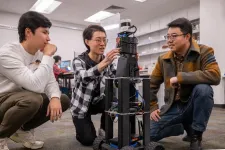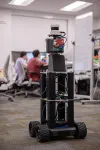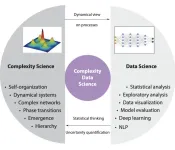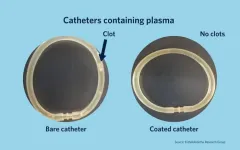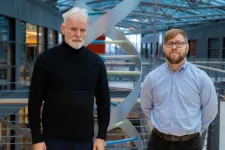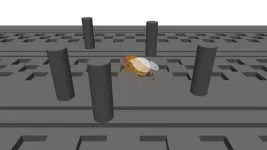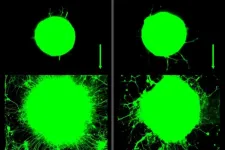(Press-News.org) In the race to develop robust perception systems for robots, one persistent challenge has been operating in bad weather and harsh conditions. For example, traditional, light-based vision sensors such as cameras or LiDAR (Light Detection And Ranging) fail in heavy smoke and fog.
However, nature has shown that vision doesn't have to be constrained by light’s limitations — many organisms have evolved ways to perceive their environment without relying on light. Bats navigate using the echoes of sound waves, while sharks hunt by sensing electrical fields from their prey's movements.
Radio waves, whose wavelengths are orders of magnitude longer than light waves, can better penetrate smoke and fog, and can even see through certain materials — all capabilities beyond human vision. Yet robots have traditionally relied on a limited toolbox: they either use cameras and LiDAR, which provide detailed images but fail in challenging conditions, or traditional radar, which can see through walls and other occlusions but produces crude, low-resolution images.
Now, researchers from the University of Pennsylvania School of Engineering and Applied Science (Penn Engineering) have developed PanoRadar, a new tool to give robots superhuman vision by transforming simple radio waves into detailed, 3D views of the environment.
"Our initial question was whether we could combine the best of both sensing modalities," says Mingmin Zhao, Assistant Professor in Computer and Information Science. "The robustness of radio signals, which is resilient to fog and other challenging conditions, and the high resolution of visual sensors."
In a paper to be presented at the 2024 International Conference on Mobile Computing and Networking (MobiCom), Zhao and his team from the Wireless, Audio, Vision, and Electronics for Sensing (WAVES) Lab and the Penn Research In Embedded Computing and Integrated Systems Engineering (PRECISE) Center, including doctoral student Haowen Lai, recent master’s graduate Gaoxiang Luo and undergraduate research assistant Yifei (Freddy) Liu, describe how PanoRadar leverages radio waves and artificial intelligence (AI) to let robots navigate even the most challenging environments, like smoke-filled buildings or foggy roads.
PanoRadar is a sensor that operates like a lighthouse that sweeps its beam in a circle to scan the entire horizon. The system consists of a rotating vertical array of antennas that scans its surroundings. As they rotate, these antennas send out radio waves and listen for their reflections from the environment, much like how a lighthouse's beam reveals the presence of ships and coastal features.
Thanks to the power of AI, PanoRadar goes beyond this simple scanning strategy. Unlike a lighthouse that simply illuminates different areas as it rotates, PanoRadar cleverly combines measurements from all rotation angles to enhance its imaging resolution. While the sensor itself is only a fraction of the cost of typically expensive LiDAR systems, this rotation strategy creates a dense array of virtual measurement points, which allows PanoRadar to achieve imaging resolution comparable to LiDAR. "The key innovation is in how we process these radio wave measurements," explains Zhao. "Our signal processing and machine learning algorithms are able to extract rich 3D information from the environment."
One of the biggest challenges Zhao's team faced was developing algorithms to maintain high-resolution imaging while the robot moves. "To achieve LiDAR-comparable resolution with radio signals, we needed to combine measurements from many different positions with sub-millimeter accuracy," explains Lai, the lead author of the paper. "This becomes particularly challenging when the robot is moving, as even small motion errors can significantly impact the imaging quality."
Another challenge the team tackled was teaching their system to understand what it sees. "Indoor environments have consistent patterns and geometries," says Luo. "We leveraged these patterns to help our AI system interpret the radar signals, similar to how humans learn to make sense of what they see." During the training process, the machine learning model relied on LiDAR data to check its understanding against reality and was able to continue to improve itself.
"Our field tests across different buildings showed how radio sensing can excel where traditional sensors struggle," says Liu. "The system maintains precise tracking through smoke and can even map spaces with glass walls." This is because radio waves aren't easily blocked by airborne particles, and the system can even "capture" things that LiDAR can't, like glass surfaces. PanoRadar's high resolution also means it can accurately detect people, a critical feature for applications like autonomous vehicles and rescue missions in hazardous environments.
Looking ahead, the team plans to explore how PanoRadar could work alongside other sensing technologies like cameras and LiDAR, creating more robust, multi-modal perception systems for robots. The team is also expanding their tests to include various robotic platforms and autonomous vehicles. "For high-stakes tasks, having multiple ways of sensing the environment is crucial," says Zhao. "Each sensor has its strengths and weaknesses, and by combining them intelligently, we can create robots that are better equipped to handle real-world challenges."
This study was conducted at the University of Pennsylvania School of Engineering and Applied Science and supported by a faculty startup fund.
END
Giving robots superhuman vision using radio signals
2024-11-12
ELSE PRESS RELEASES FROM THIS DATE:
Digital twins and complexity data science
2024-11-12
A Perspective suggests that “digital twins” are not simply tools for science but are an example of the integration of complexity science and data science into a new scientific field. A “digital twin” is a digital representation of a real-world object or system. The idea emerged from manufacturing but has been adopted by science, especially by the fields of medicine, immunology, and epidemiology. Digital twins are typically frequently or continuously updated and improved with real data from the real object the digital twin mirrors, allowing ...
‘Moonlighting’ enzymes can lead to new cancer therapies
2024-11-12
Researchers at the Centre for Genomic Regulation (CRG) reveal that metabolic enzymes known for their roles in energy production and nucleotide synthesis are taking on unexpected "second jobs" within the nucleus, orchestrating critical functions like cell division and DNA repair.
The discovery, reported across two separate research papers out today in Nature Communications, not only challenges longstanding biological paradigms in cellular biology but also opens new avenues for cancer therapies, particularly against aggressive tumours like triple-negative breast cancer (TNBC).
For decades, biology textbooks have neatly compartmentalised ...
One genomic test can diagnose nearly any infection
2024-11-12
Next-generation metagenomic sequencing test developed at UCSF proves its effectiveness in quickly diagnosing almost any kind of pathogen.
A genomic test developed at UC San Francisco to rapidly detect almost any kind of pathogen – virus, bacteria, fungus or parasite – has proved successful after a decade of use.
The test has the potential to vastly improve care for neurological infections that cause diseases like meningitis and encephalitis, as well as speed up the detection of new viral pandemic threats. It uses a powerful genomic sequencing ...
Blood vessel-like coating could make medical devices safer for patients
2024-11-12
University of B.C. researchers have developed a groundbreaking coating that could make medical devices safer for millions of patients, reducing the risks associated with blood clots and dangerous bleeding.
The new material, designed to mimic the natural behavior of blood vessels, could allow for safer use of blood-contacting devices like catheters, stents, blood-oxygenation machines and dialysis machines—especially in cases where blood clots are a significant concern.
“This discovery could be a transformative step in the development of safer medical devices,” said Dr. Jayachandran Kizhakkedathu, ...
Sleep is no light matter for bees
2024-11-12
In an emerging red flag for the digital era, sleep experts have warned us to avoid screen time in bed, sounding the alarm that light emitted from phones and other electronic devices can disrupt our sleep patterns. That’s one way that science is waking up to the broad range of health and disease implications related to circadian biology and our daily sleep-wake cycles.
Now, researchers at the University of California San Diego have found that light disruption is not only a health concern for humans. A new study led by PhD candidate Ashley Kim and Professor James Nieh in the School of Biological Sciences has found that artificial light disrupts the circadian rhythms of ...
New study explores the role of BMI in disease risk
2024-11-12
New study from deCODE genetics/Amgen highlights the importance of BMI in pathogenesis of disease, suggesting that reducing BMI alone could lower the risk of several diseases.
Scientists at deCODE genetics, subsidiary of Amgen, published a study today in Nature Communications that sheds light on how Body Mass Index (BMI) influences the risk of various diseases that are comorbid with obesity. The study, which used genetic data from Iceland and the UK Biobank, looked at whether disease risk associated with BMI-related sequence variants are explained completely or partially by their effect on BMI.
The results showed that for some conditions, such as fatty liver disease, glucose intolerance, ...
Guardian, kids, or companions? What do dogs mean to us today
2024-11-12
What role do dogs play in today’s world? For many, they are more than just pets. New findings from the Department of Ethology at Eötvös Loránd University show that whether seen as friends, family members, children or guardians, these roles affect the way dogs are cared for, suggesting shifting dynamics in human-animal bonds shaped by societal trends and individual owner profiles.
In Western cultures, more and more people see their dogs as their best friends, family members or even their furry children. In fact, ...
NeuroMechFly v2: Simulating how fruit flies see, smell, and navigate
2024-11-12
All animals, large or small, have to move at an incredible precision to interact with the world. Understanding how the brain controls movement is a fundamental question in neuroscience. For larger animals, this is challenging because of the complexity of their brains and nervous systems. But the fruit fly, Drosophila melanogaster, has a smaller and therefore more easily mappable brain, allowing scientists to gain detailed insights into how its nervous system drives behavior.
To understand how the nervous system controls actions, researchers at the group of Pavan Ramdya at EPFL created a simulated reality where a virtual fly can operate ...
“Drowning” mangrove forests in Maldives signal global coastal threat
2024-11-12
Researchers have found evidence that mangrove forests – which protect tropical and subtropical coastlines – are drowning in the Maldives.
Their findings, published today (Tuesday 12 December) in Scientific Reports, indicate that rising sea level and a climate phenomenon known as the Indian Ocean Dipole have led to some Maldivian islands losing over half of their mangrove cover since 2020.
The research team, led by Northumbria University, warn that the findings have implications not only for the Maldives, but also for other island nations and coastal ecosystems around the world.
In 2020, more than a quarter of the Maldivian islands containing mangrove forests saw their trees experiencing ...
When muscles work out, they help neurons to grow, a new study shows
2024-11-12
There’s no doubt that exercise does a body good. Regular activity not only strengthens muscles but can bolster our bones, blood vessels, and immune system.
Now, MIT engineers have found that exercise can also have benefits at the level of individual neurons. They observed that when muscles contract during exercise, they release a soup of biochemical signals called myokines. In the presence of these muscle-generated signals, neurons grew four times farther compared to neurons that were not exposed to myokines. These cellular-level experiments suggest that exercise can have a significant biochemical effect on nerve growth.
Surprisingly, the researchers also ...
